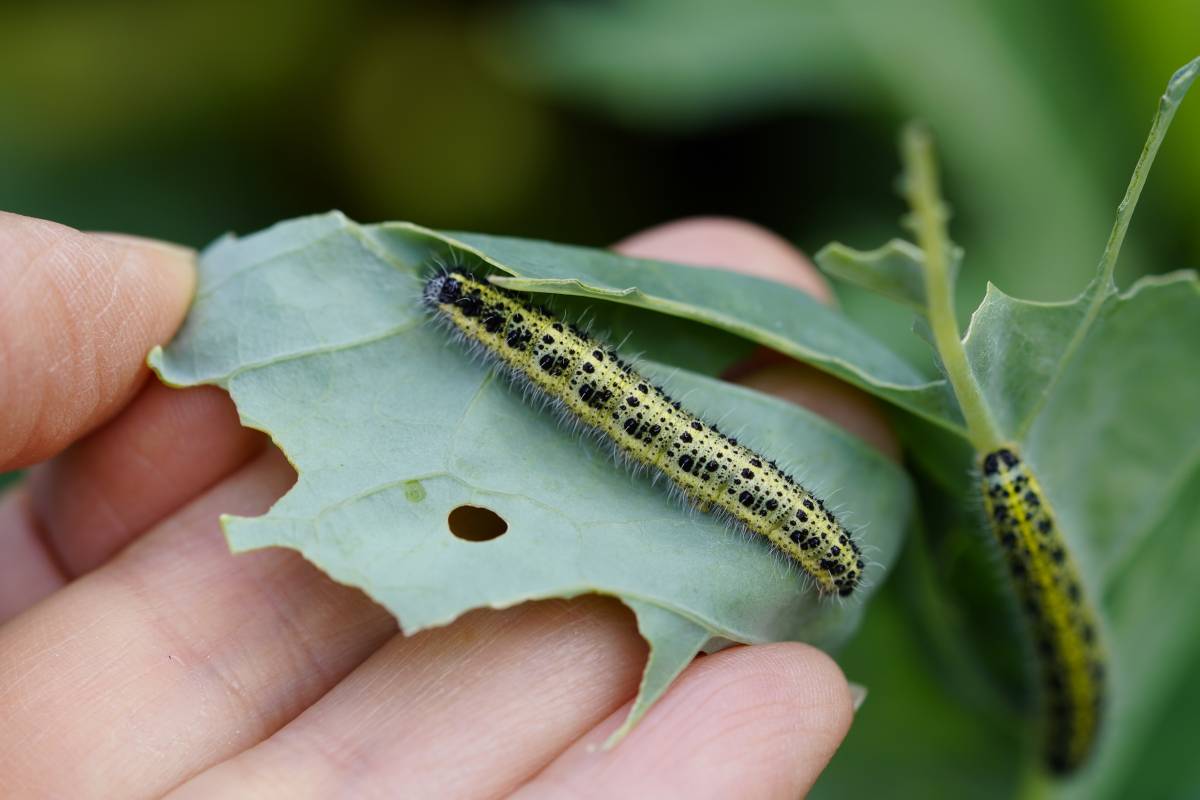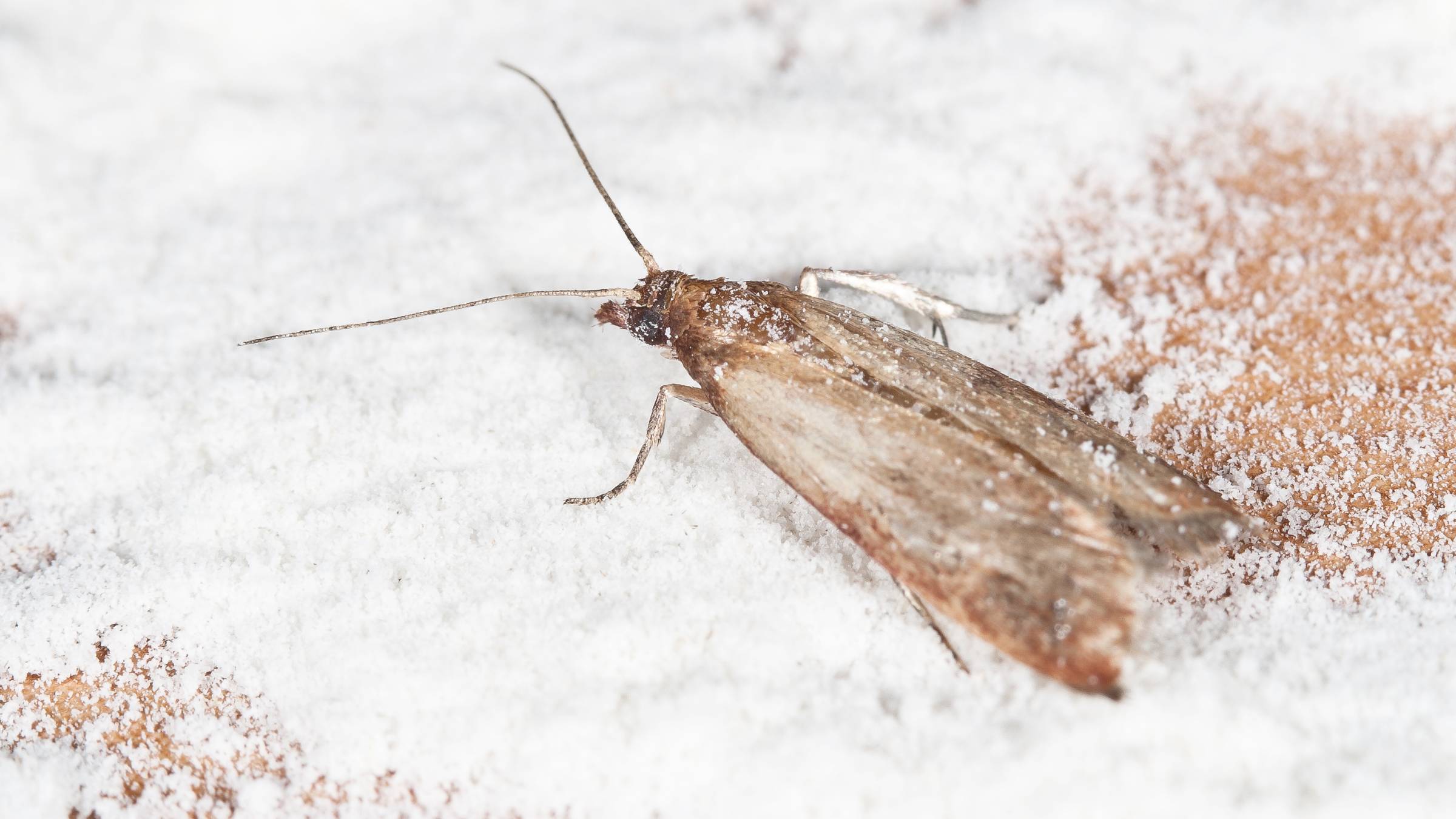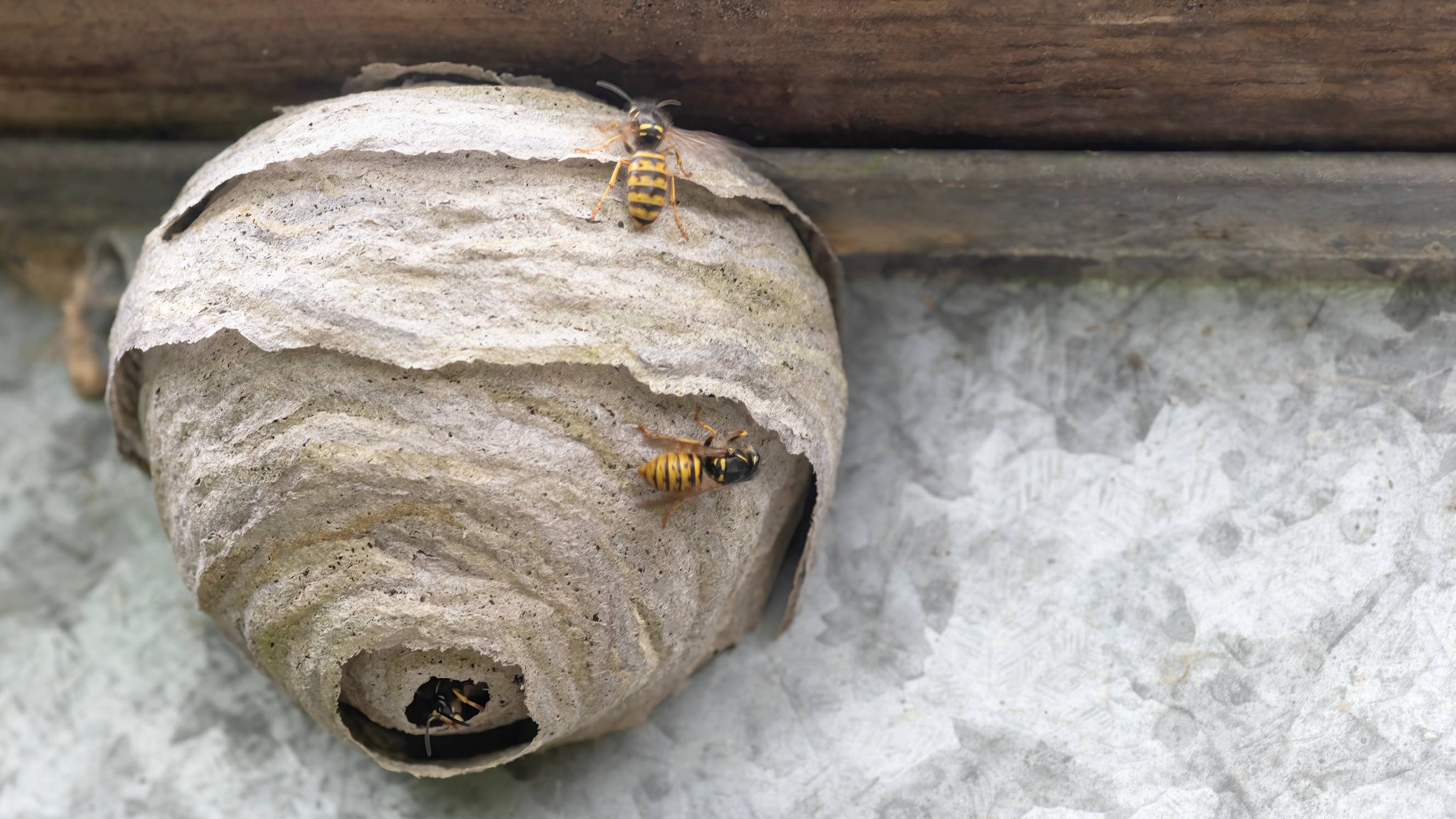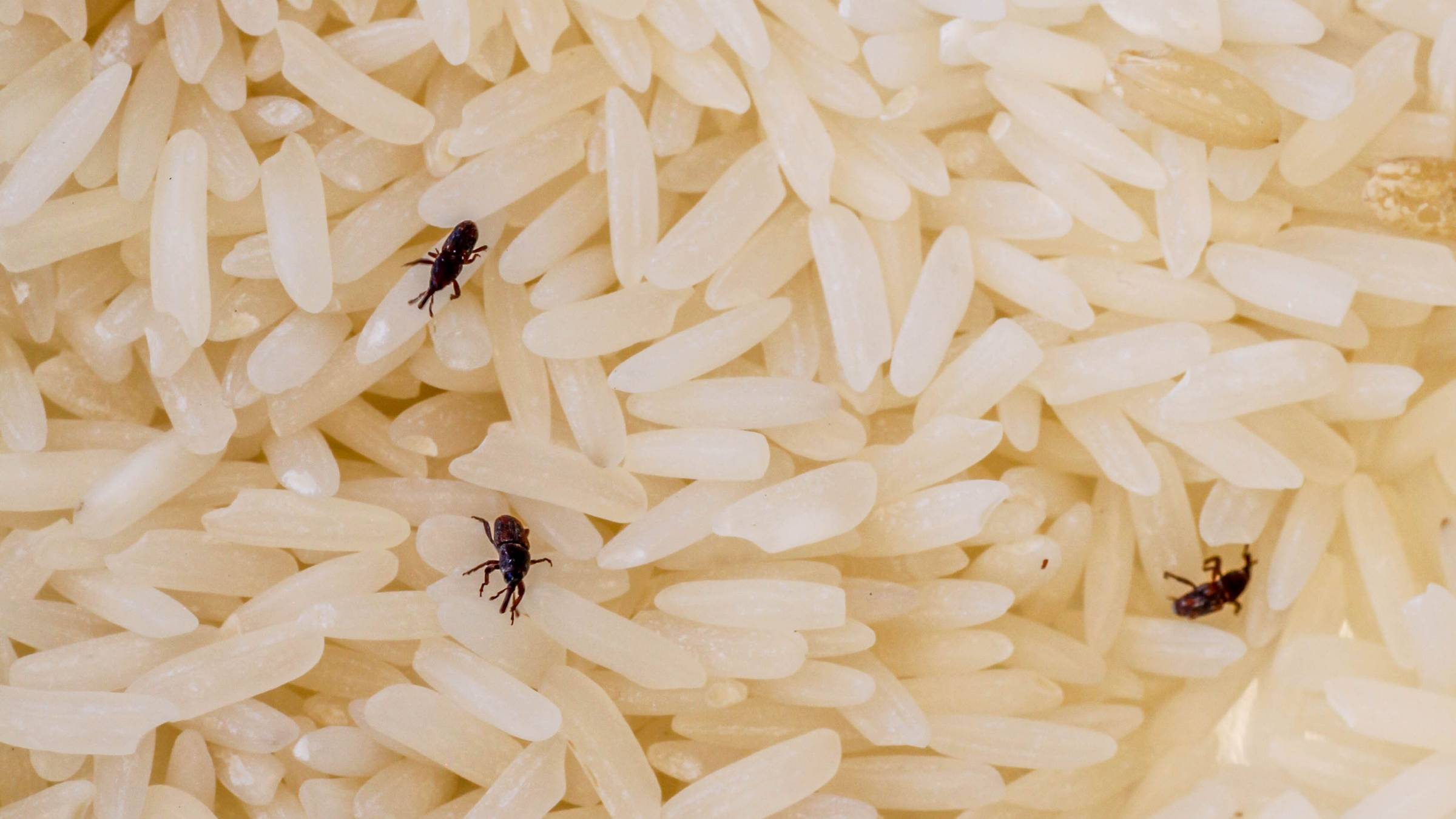
- Home/
- Guides/
- Pest Control/
- How to Get Rid of Weevils
A helpful guide to a weevil-free pantry
Learn step-by-step methods to eliminate rice weevils and keep your dry goods safe.
Last Updated on

Written by Angela A.
Staff Writer
Read more about our contributor
|
Skill level |
Estimated completion time |
Estimated cost |
|---|---|---|
| Beginner—no special tools or experience required |
From a couple of minutes to a couple of days |
No cost if using products already found in your home |
Key Takeaways
Pantry weevils are small beetles that infest and feed on stored dry foods like flour, rice, pasta, and grains.
Weevils become a problem because they contaminate stored food with their eggs, larvae, and waste, making it unsuitable for people to eat.
To quickly stop them from spreading, keep dry goods in sealed containers instead of their original packaging.
Tiny but troublesome, weevils infest dry food like rice, flour, and pasta, often spreading unnoticed until they appear in your cupboards. Left unchecked, they multiply quickly, making them difficult to remove.
If you're dealing with a weevil infestation, this guide will take you through an easy step-by-step process on how to get rid of rice weevil infestation naturally. With the right storage and cleaning habits, you can protect your food and keep your kitchen free from pests.
What are weevils and are there different types of weevils?
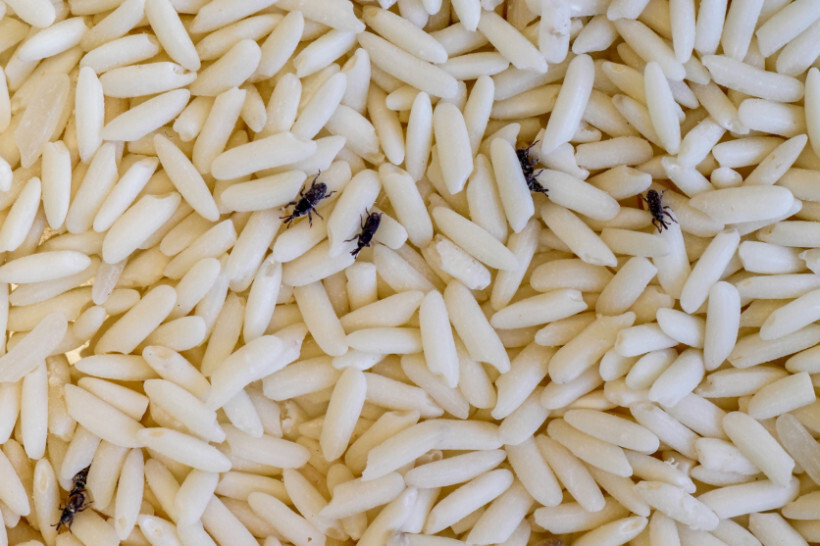 Infested dry goods like rice should be discarded immediately to prevent spreading. (Source: iStock)
Infested dry goods like rice should be discarded immediately to prevent spreading. (Source: iStock)
Unlike other pests, like termites and cockroaches, weevils are especially unpleasant to see in your pantry or kitchen because they don’t just eat food—they live in it. They burrow into grains, lay their eggs inside, and turn your stored food into both a home and a feeding ground for their larvae. It’s also why they are dangerous because there might be weevils inside your stored food, and you wouldn’t know it.
Weevils come in different shapes and sizes, but weevils in rice and flour are among the most common in households. One of the reasons they can be initially hard to detect is their small size and ability to hide within dry food products.
These reddish-brown pests, typically 2.5–3.5mm in length, burrow into grains, where they lay their eggs. As the larvae develop inside, they feed on the food itself, making infestations difficult to notice until the damage is already done. By the time you spot adult weevils crawling in your pantry, they may have already spread to other stored foods.
Signs of a weevil infestation in your home
Since they often go unnoticed until the infestation is well underway, identifying the early signs is crucial. Here are some key indicators to watch for:
Presence of small brown or black beetles in or around pantry shelves and food containers.
Tiny holes in food packaging can mean larvae may have already contaminated your food.
Infested grains leave behind a dusty or fine powdery residue in food containers.
Larvae activity can cause flour and grains to clump together or develop silky webbing.
The presence of other insects near dry food may indicate a wider infestation.
Contaminated grains or flour that have developed a musty or stale smell.
Stored grains may appear different or discoloured if they’ve been infested.
How to get rid of rice weevils in kitchen
Weevils in kitchen cupboards can spread quickly, but with the right approach, you can eliminate them and stop them from coming back. Follow this step-by-step guide to tackle an infestation effectively.
Step 1: Identify the source of infestation
 Organising pantry items in sealed containers helps prevent weevil infestations from spreading. (Source: iStock)
Organising pantry items in sealed containers helps prevent weevil infestations from spreading. (Source: iStock)
Before removing weevils, you need to locate their source. Check all dry food stored in your cupboards, paying close attention to grains, rice, flour, pasta, and dried fruits.
Inspect both opened and unopened packaging for live insects, webbing, or fine powdery residue. Also, check for any signs of infestation in cracks, behind appliances stored in these areas. If you notice damaged packaging or visible pests, you likely have a weevil problem.
Step 2: Safely remove infested food
Once you’ve identified contaminated food, the next step is to remove it to prevent further spread.
Seal infested food in plastic bags and dispose of it in an outdoor bin to stop weevils from escaping. Avoid composting affected grains, as larvae and eggs may survive and spread further. Before restocking your cupboard, inspect nearby food items to see if they remain unaffected.
Step 3: Clean and disinfect your pantry shelves
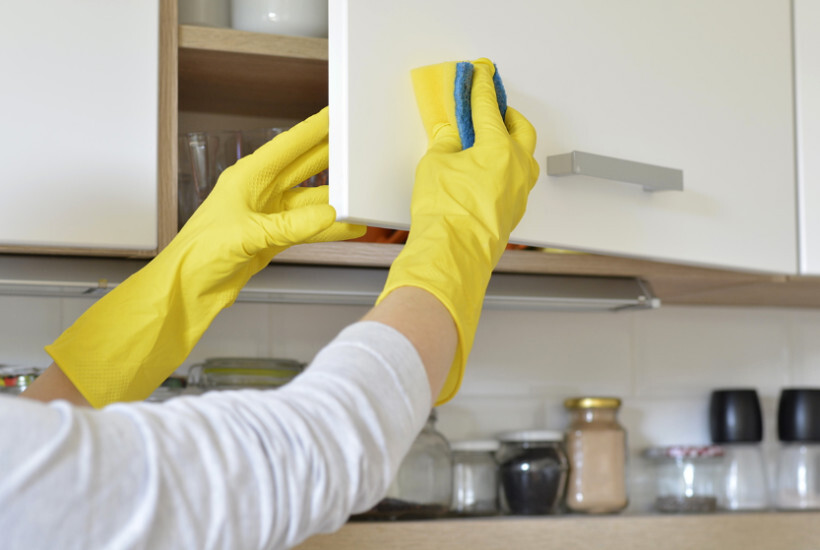 Cleaning shelves thoroughly is a key step to removing pantry weevil eggs and larvae. (Source: iStock)
Cleaning shelves thoroughly is a key step to removing pantry weevil eggs and larvae. (Source: iStock)
Thoroughly clean your cupboards to eliminate any lingering weevils or eggs. Remove all remaining food items and vacuum the shelves, corners, and crevices to clear out any hidden larvae or eggs.
Wipe down surfaces with a solution of white vinegar and water or a mild detergent to disinfect the area. Allow the shelves to dry completely before restocking. For extra protection, consider placing dried bay leaves or cloves in storage areas, as their scent may help deter weevils.
Step 4: Inspect nearby areas for hidden infestations
Even if your kitchen cupboards appear weevil-free, check other potential hiding spots, like pet food, seed bags, dried flowers, and any other places where dry goods are stored. Look behind appliances, inside kitchen drawers, and even in rubbish bins for stray weevils or eggs.
To be safe, consider carrying out a full house clean to remove any hidden pests. Vacuum carpets, clean storage spaces, and inspect any rarely used areas where dry goods may be kept.
Step 5: Practise proper food storage in the future
 Using airtight glass containers helps block weevils from getting into your pantry staples. (Source: iStock)
Using airtight glass containers helps block weevils from getting into your pantry staples. (Source: iStock)
Practising proper food storage is key to stopping future weevil infestations. Here are some food storing tips you can try to prevent weevil infestation.
Avoid storing food in its original packaging, as thin plastic bags and cardboard boxes are easy for weevils to chew through. Transfer dry goods like grains, flour, and pasta into airtight glass, plastic, or metal containers to keep pests out.
Inspect your food when you buy it. Bugs in rice and granary weevils are especially easy to spot, so a quick check-in every now and then can save your pantry from a nightmare.
Label containers with purchase dates to maintain proper food rotation and ensure freshness.
How to remove rice weevils naturally in the kitchen
If you’re looking for a natural way to eliminate weevils from your cupboards, there are some methods that can help. These solutions not only remove existing infestations but also prevent future ones by making storage areas less inviting to pests. Here are three simple and effective ways to tackle weevils using common household ingredients.
Make a vinegar and water spray solution
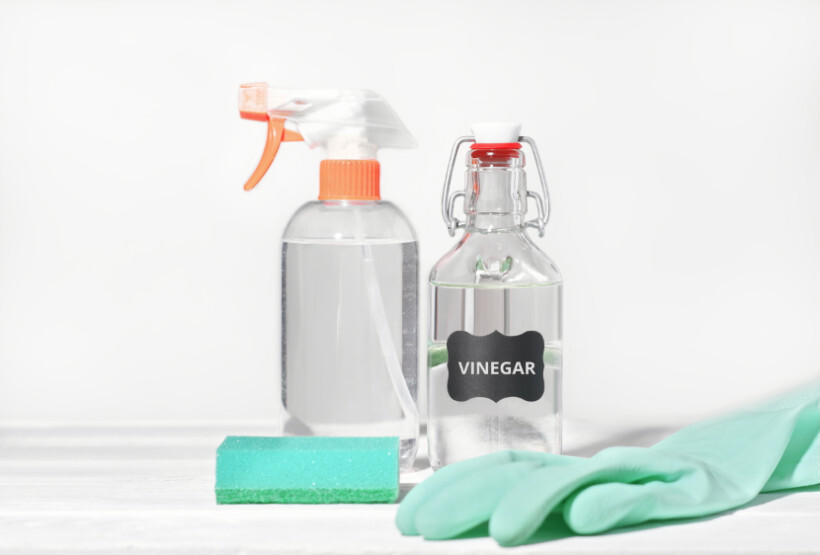 Vinegar is a safe and natural disinfectant to clean pantry surfaces after an infestation. (Source: iStock)
Vinegar is a safe and natural disinfectant to clean pantry surfaces after an infestation. (Source: iStock)
Vinegar is a natural disinfectant that helps eliminate weevils and sanitise storage spaces. Start by mixing equal parts white vinegar and water in a spray bottle and use the solution to clean cupboards, shelves, and other areas where you store your food products. While it’s great for cleaning surfaces, it probably isn’t the best when it comes to treating infested food.
Take advantage of extreme temperatures to save stored food
If you notice minimal weevil activity and want to save your dry goods, using the heat or cold in your kitchen can be a great solution. Dry foods, like grains and pasta, can be heated in the oven at a low temperature for 15–20 minutes to eliminate adult weevils. It’s great for cleaning dry food, but it won’t remove unhatched eggs.
To target eggs, repeat the heating process a week after they’ve hatched. Alternatively, freezing affected food for at least 24 hours will kill weevils regardless of their life stage, making it a more effective method for items that cannot be heated.
Use natural deterrents
 Aromatic spices like bay leaves and cinnamon may help repel pantry pests naturally. (Source: iStock)
Aromatic spices like bay leaves and cinnamon may help repel pantry pests naturally. (Source: iStock)
Bay leaves, cloves, and black peppercorns are common kitchen ingredients that can naturally repel weevils and other pests. Simply place them inside food storage containers or on cupboard shelves to keep weevils away. Replace them every few months to maintain their effectiveness.
Common mistakes to avoid when dealing with weevils in the kitchen
Getting rid of weevils can require a thorough and diligent approach, but many homeowners make mistakes that leave the infestation to persist. Properly addressing these common errors can mean your pantry stays pest-free.
Not checking all dry food items. Weevils spread fast, so it’s not enough to just throw out infested food. Always inspect all dry goods, including those in unopened packages.
Skipping the cleaning after disposal. Simply removing affected food doesn’t fully resolve the issue since eggs and larvae can stay in cupboard corners and shelves. After experiencing weevils and other pests in your home, a deep clean, including vacuuming and disinfecting, is recommended.
Reusing infested containers. Even if a container looks clean, it may still contain weevil eggs. Wash all storage containers thoroughly with hot, soapy water to prevent another infestation. Alternatively, you can use bleach to clean these containers—just be sure to handle it with care. Be sure to clean cupboard corners as well, and consider professional help for pesticide use near food.
Not checking for cracks and crevices. Weevils can hide in tiny spaces, like shelf cracks, baseboards, and even behind appliances. Pay close attention to these areas when cleaning to eliminate any hidden pests.
Missing routine inspections. If you're not careful, a single infestation can quickly return. To prevent weevils from returning, check your food storage space regularly, rotate food supplies, and store dry goods in airtight containers.
Get a weevil-free cupboard
It can be frustrating to deal with a weevil infestation, but proper steps can help you eliminate it and prevent future infestations. The best ways to prevent infestations are regularly inspecting your dry goods, using airtight storage, and keeping your cupboards clean. By making these simple habits part of your routine, you can protect your food and keep your kitchen pest-free.
If you need extra help, Airtasker makes it easy to find experienced pest control services that can handle weevil infestations efficiently. From thorough inspections to tailored treatment plans, you can connect with experts who will help you maintain a clean, pest-free home with ease.
Learn more about our contributors

Written by Angela A.
Staff Writer
Angela Apolonio is an experienced writer with a Biology background. She writes about home tips, car upkeep, gardening hacks, and food facts, bringing a unique blend of science and practicality to her work. As a wife and a mother, she knows the value of iron-clad routines, so she's passionate about sharing what works for her with everyone else. She loves making everyday life simpler and helping readers find fresh ideas to bring more joy into their spaces.
FAQs on pantry weevils
Yes, weevils can be a common issue in UK homes, especially in stored dry goods like flour, rice, and pasta.
Weevils can survive in colder UK climates but thrive in warm, humid environments. Although they may be less active in winter, they can still infest cupboards if they find a food source.
It’s best not to throw infested food in your council food waste bin unless your local waste collection allows it. Sealing it in a plastic bag and disposing of it in the general waste bin is a safer option.
Bay leaves and cloves are believed to repel weevils due to their strong scent, but they are not a guaranteed solution for eliminating an infestation.
Find pest control, fast
Find a Pest Control specialist
Related articles
Related price guides


